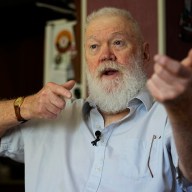“Poolates stays true to the work of Joseph Pilates,” explains Boo Pfeiffer, founder of Poolates. “With the difference that the lower impact on joints and muscles makes it more accessible.”
Being in the water allows people whose injuries, arthritis or weight prohibits them from carrying out certain moves to participate in the workout.
The principle of Pilates is based on precision, control, concentration and breathing and how all of these come together. The key thing is that contrary to belief, Poolates does not involve floating around in the water. The class is performed standing up, on the pool steps or the side railing, and only once you have reached an advanced level do you engage in horizontal moves.
In Poolates you have to resist the buoyancy, which is challenging, but it is a more gentle feeling than fighting gravity, making the exercise more relaxing as a whole. “You get more of a mind-body high,” explains Pfeiffer. “You are able to relax more and therefore focus and concentrate on the moves more easily.”
Every single exercise during Poolates engages your core, stomach, back and waist muscles. If you don’t hold it all together in an integrated fashion and keep the moves precise, then you will be thrown off balance and have to fight your way back against the water.
Like regular Pilates, each exercise begins with postural organization — if you’re not in the proper position from the start, you will not have any control over the movement. You need to work in order to stop yourself from flopping over.
Water acts as a harness on the body, and as a result, if you do a move incorrectly, you are more likely to feel it than if you were on a mat, as you will probably fall over.
“It’s bio-feedback,” says Pfeiffer. “You feel water on your body in a way that you don’t feel air, meaning there is no margin of error in the water.”
















